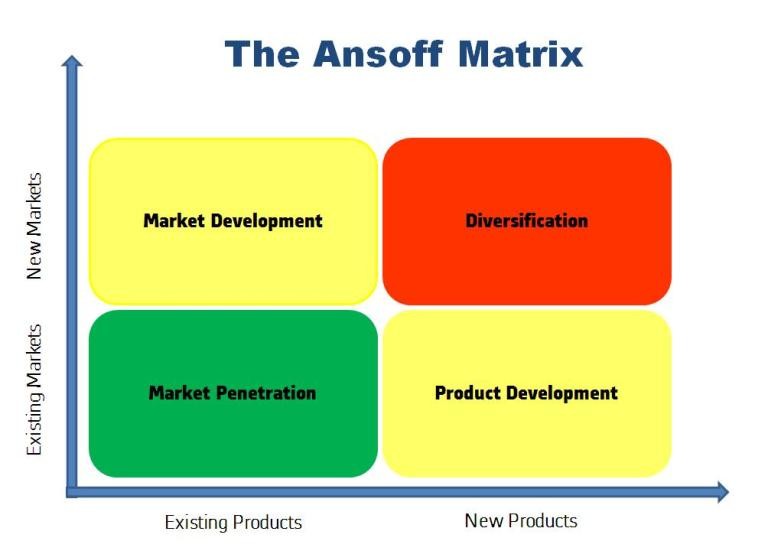Almost everyone in the marketing field will have heard of Ansoff Matrix and many of you will have already used it in some context. In this article, we explore how best to utilise Ansoff Matrix to understand business risks.
We further delve into the strategising process of countering these risks and develop an action plan to mitigate the effects of these risks.
Whether you are an established business or a new one, you can look at the market in four primary segments as shown below:
 Source: https://en.wikipedia.org/wiki/Ansoff_Matrix#/media/File:Ansoff_Matrix.JPG
Source: https://en.wikipedia.org/wiki/Ansoff_Matrix#/media/File:Ansoff_Matrix.JPG
Each of these areas defines the strategy you can follow to identify your marketing needs. It can also help you understand the key risks facing your market and find a way around it.
Market Penetration
This is represented by the first quadrant in the Ansoff Matrix. It simply refers to expanding your sales/market size in the existing market. This does not need massive innovation in the product or change in the service offering. It might need a few changes in packaging your sales. It can be achieved through a lot of ways. Some examples are:
- Developing a distributor channel
- Price reduction/promotions. Discounts, etc
- Loyalty schemes
- Increasing sales staff
To achieve this, you will need to identify your USP or key selling point. It is usually the least risk option. Statistically, this approach would yield you a greater % of success. The returns may not be as exciting as the other. But it will provide you results at lower risks.
If you are a startup or a small business, it is not the best advice to start on this mode. The problem is – there are already too many established players. The market is competitive. Unless you have the ability to sustain losses and beat out the other players in this market, it usually is a place for established players. Having said that you can still operate in this segment if you are innovative. The challenge however is a tough one. You will usually need more time than you think.

Market Development
Market development refers to expanding sales to a completely new market. If you are a business planning to take on a new geographical area, you automatically fall into this area. The biggest advantage you have in this segment is that you already have a product and an established market. You can rely on this success story and try to sell it to other customers.
Be careful to understand the impact of cultural factors in an external market. You might have been successful in home turf. But when you are playing an unknown market, the risks are also unknown. A good way to counter some of these risks is by performing a simple PESTLE analysis to understand key risks. It may be that you need a local representative. Or perhaps an area specific partner.
You may also do well by franchising your product or service to the local area experts. This can help reduce your risks. The risks are slightly higher when compared to market penetration. But you can still bank on your previous success story. You will have to establish the market need and cater to the local environment.
Product Development
This is a slightly riskier strategy in the Ansoff matrix. It refers to selling different products to an existing customer base. The risk in this segment is the investment in product development. It can relate to adding new features to an existing product. It can also refer to developing related products or adding a service element to existing solutions.
A good starting point for product development is in understanding your customer. Being passionate about product development, we have touched upon Voice of Customer which talks about understanding customer needs.
We have also talked about Minimum Viable Product and how you can involve the customer in product development. All these tools/strategies help you understand the customer better. A good amount of research in identifying the hidden needs of customers can also benefit product development largely. In all essence, this will still qualify as a risky strategy. But the gains from such a risk can be high.
If you are a startup or small business, this is not a bad area to delve into. The amount of competition in this segment is slightly lower as opposed to Market Penetration and Market Development.

Diversification
This is the riskiest strategy in Ansoff Matrix. Not only are you looking at a new product, but also a new market. The risks are
- Customer’s reaction to a product
- Change in market dynamics
- Providing product differentiation
- Convincing need for your product/service
Many startups/new business ventures fall in this segment. This has the highest risk, but can also provide the best benefits. If you are a startup looking for investment, this area might be the right one to seek investors. If they are seasoned investors who understand the risks – you not only gain access to their experience, but also the network which can be exceedingly powerful.
Key approaches in this segment are Minimum Viable Product approach, prototyping and development in partnership for a specific client. Either of these approaches can provide you with the crucial market information you need to develop your product/service further.
The above four areas in Ansoff Matrix act as beacons of light for risks in your marketing strategy. It is highly imperative that you understand which segment you fall under. Once you identify the area, you can then start looking at solutions to tackle the associated risks.
Arrange a Conversation
Read more articles tagged:
Digital Marketing, Featured










